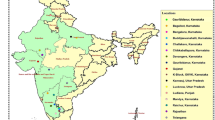Abstract
Bipolaris sorokiniana is a phytopathogenic fungus that causes diseases in cereal crops. The high morphological, physiological, and genetic variability makes the control of this fungus a difficult task. The aim of this work was to study the virulence, morphological, and physiological variability of B. sorokiniana isolates. For this, 35 B. sorokiniana isolates from different geographic regions in Brazil and other countries were used. The isolates were evaluated for their morphological variability, considering mycelium color, sector formation, and growth rate. Based on these morphological characteristics, the isolates were grouped in five different morphological groups. Extracellular enzymes activity in solid medium, virulence in wheat seeds and seedlings, and analysis of total proteins by SDS-PAGE were evaluated for all isolates. Variations among the isolates were found for enzymatic activity, and esterase was the enzyme that showed the highest activity indices. The results obtained from infection of seeds and seedlings showed that isolates from the same geographical region and morphological group had different degrees of virulence. The total protein profile shown by the isolates varied in the number of bands and intensity, where some of them may be used to characterize the specie.


Similar content being viewed by others
References
Alfenas AC, Peters I, Brune W, Passador GC (1991) Eletroforese de proteínas e isoenzimas de fungos e essências florestais. Universidade Federal de Viçosa, Viçosa, Minas Gerais
Arabi MI, Jawhar M (2004) Identification of Cochliobolus sativus (spot blotch) isolates expressing differential virulence on barley genotypes in Syria. J Phytopathol 152:461–464
Bettiol W, Ghini R (2002) Controle Biológico In: Kimati H, Peixoto Neto PAS, Azevedo JL, Araújo WL. Microrganismos endofíticos. Biotecnologia, Ciência e Desenvolvimento 29:62–76
Brasil (1992) Regras para Análise de Sementes. Brasília, Ministério da Agricultura e Reforma Agrária
Comissão Sul-Brasileira de Pesquisa De Trigo (2005) Indicações técnicas da Comissão Sul-Brasileira de pesquisa de trigo. Trigo e triticale. Passo Fundo, Embrapa Trigo
Farias CRJ, Del Ponte EM, Lucca Filho AO, Pierobom CR (2005) Fungos causadores de helmintosporiose associados às sementes de aveia-preta (Avena strigosa, Schreb). R Bras Agrociência 11:57–61
Griffin DH (1994) Fungal physiology, 2nd edn. Wiley, New York
Haba E, Bresco O, Ferrer C, Marqués A, Busquets M, Manresa A (2000) Isolation of lipase-secreting bacteria by employing used frying oil as selective substrate. Enzyme Microbial Technol 26:40–44
Hankin L, Anagnostakis SL (1975) The use of solid media for detection of enzyme production by fungi. Mycologia 67:597–607
Jaeger KE, Reetz MT (1998) Microbial lipases form versatile tools for biotechnology. Trends Biotechnol 16:396–403
Jaiswal SK, Sweta S, Prasad LC, Sharma S, Kumar S, Prasad R, Pandey SP, Chand R, Joshi AK (2007) Identification of molecular marker and aggressiveness for different groups of Bipolaris sorokiniana isolates causing spot blotch disease in wheat (Triticum aestivum L.). Curr Microbiol 55:135–141
Lealem F, Gashe BA (1994) Amylase production by a gram-positive bacterium isolated from fermenting tef (Eraglostis tef). J Appl Bacteriol 77:348–352
Lilly VG, Barnett HL (1951) Physiology of the fungi. McGraw-Hill, New York
Mahmoud YAG, Gaafar RM, Mubarak HM (2007) Genetic diversity among Nile Delta isolates of Rhizoctonia solani Kuhn based on pathogenicity, compatibility, isozyme analysis and total protein pattern. Turk J Bot 31:19–29
Muller MVG, Germani JC, Van Der Sand ST (2005) The use of RAPD to characterize Bipolaris sorokiniana isolates. Genet Mol Res 4:642–652
Nascimento EJM, Van Der Sand ST (2008) Restriction analysis of the amplified ribosomal DNA spacers ITS1 and ITS2 of Bipolaris sorokiniana isolates. World J Microbiol Biotechnol 24:647–652
Nelson RR (1960) Evolution of sexuality and pathogenicity in interspecific crosses in the genus Helminthosporium. Phytopathology 50:375–377
Oliveira AMR, Matsumura ATS, Prestes AM, Matos GS, Van Der Sand ST (1998) Variabilidade patogênica e morfológica em isolados de Bipolaris sorokiniana. Fitopatol Bras 23:349–353
Pandey SP, Sharma S, Chand R, Shahi P, Joshi AK (2007) Clonal variability and its relevance in generation of new pathotypes in the spot blotch pathogen, Bipolaris sorokiniana. Curr Microbiol 56:33–41
Paterson RRM, Bridge PD (1994) Biochemical techniques for filamentous fungi. CAB International, Wallingford, United Kingdom
Reis EM (1982) Sementes de trigo infectadas por Helminthosporium sativum: fonte de inóculo para a podridão comum de raízes e seu controle pelo tratamento com fungicidas. Summa Phytopathol 8:29–38
Reis EM, Casa RT (1998) Patologia de sementes de cereais de inverno. Aldeia Norte editora, Passo Fundo
Tanaka MAS, Mentem JOM (1991) Comparação de métodos de inoculação de sementes de algodoeiro com Colletotrichum gossypii var. cephalosporioides e C. gossypii. Summa Phytopathol 17:218–231
Tinline RD (1988) Cochliobolus sativus, a pathogen of wide host range. Adv Plant Pathol 6:113–122
Valim-Labres ME, Van Der Sand ST, Prestes A, Matsumura ATS (1997) Variação no aspecto cultural, morfológico e virulência em isolados de Bipolaris sorokiniana. Fitopatol Bras 22:483–487
Zhong S, Steffenson BJ (2001) Virulence and molecular diversity in Cochliobolus sativus. Phytopathology 91:469–476
Acknowledgments
We are grateful to Dr. Julie Nicol, Dr. Monica Mezzalama, Dr. Etienne Duveiller, and Dr. Henri Maraite from CIMMYT, Dr. Kerry O′Donnell from Microbial Genomics and Bioprocessing Research Unit, National Center for Agricultural Utilization Research- USDA for kindly providing the B. sorokiana samples from the other countries and to Dr. Airano Prestes from EMBRAPA (Passo Fundo, Brazil) for providing the B. sorokiniana isolates from barley and wheat seeds. This study was financed by CAPES/PROF.
Author information
Authors and Affiliations
Corresponding author
Rights and permissions
About this article
Cite this article
Poloni, A., Pessi, I.S., Frazzon, A.P.G. et al. Morphology, Physiology, and Virulence of Bipolaris sorokiniana Isolates. Curr Microbiol 59, 267–273 (2009). https://doi.org/10.1007/s00284-009-9429-4
Received:
Revised:
Accepted:
Published:
Issue Date:
DOI: https://doi.org/10.1007/s00284-009-9429-4




